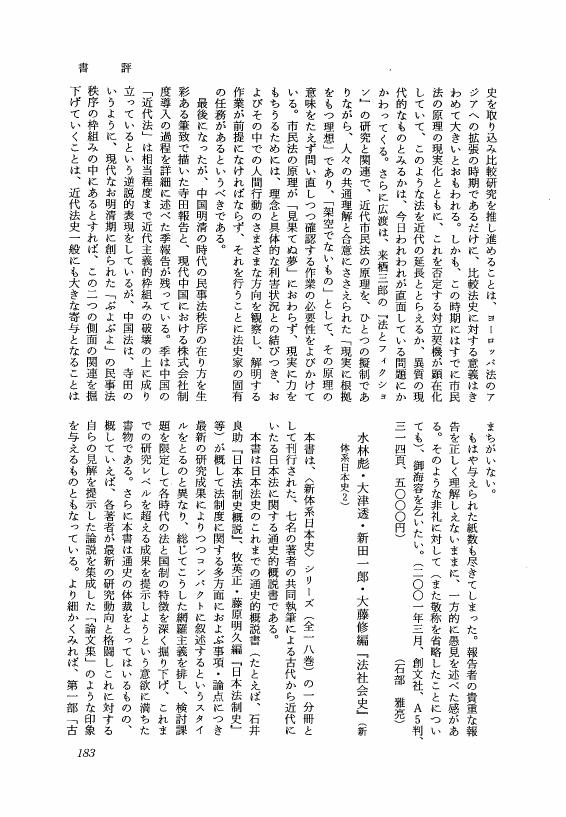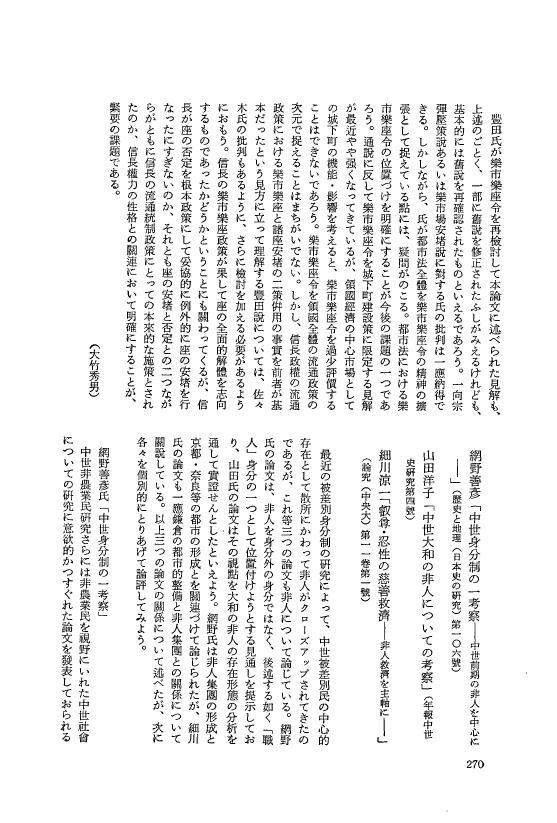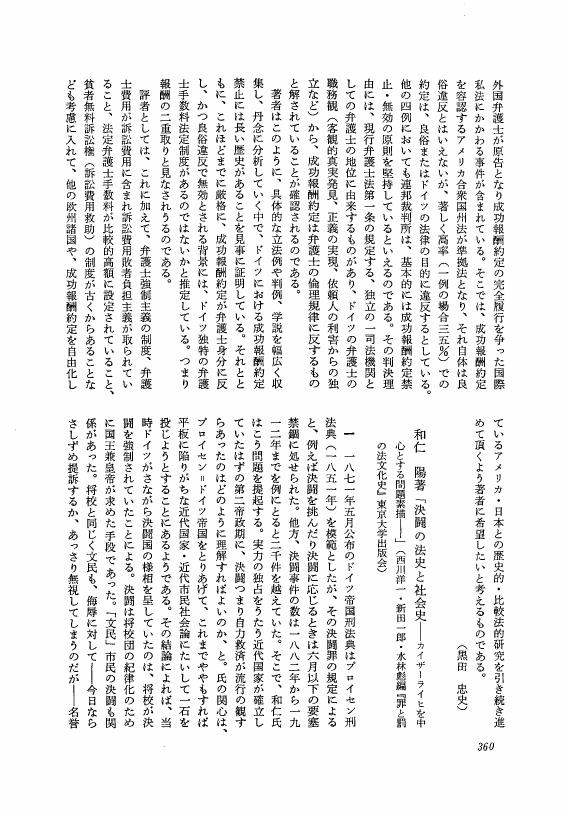- 著者
- 樋口 陽一
- 出版者
- 法制史学会
- 雑誌
- 法制史研究 (ISSN:04412508)
- 巻号頁・発行日
- no.51, pp.175-187,8, 2001
27 0 0 0 シンポジウム 法学における歴史的思考の意味:歴史学の認識手続と法学的思考
- 著者
- 木庭 顕
- 出版者
- 法制史学会
- 雑誌
- 法制史研究 (ISSN:04412508)
- 巻号頁・発行日
- no.51, pp.130-142, 2001
23 0 0 0 OA 芸娼妓契約と判例理論の展開
- 著者
- 山中 至
- 出版者
- Japan Legal History Association
- 雑誌
- 法制史研究 (ISSN:04412508)
- 巻号頁・発行日
- vol.1991, no.41, pp.1-44,en2, 1992-03-30 (Released:2009-11-16)
This paper analyzes the legal effect of Geishogi-contract in the early Meiji period, before the enforcement of Old Civil Law, with some unknown decisions of lower courts in Tokyo and Osaka.It contains, First, as for Geishogi-contract, dualistic opinions, labor contract as Geishogi was void against public policy but advance contract was valid, had been dominant during the Old Supreme Court era. In 1955, Supreme Court invalidated the long supported precedent with a unitary opinion and reversed it. This paper clarified, for the first time, that dualistic opinions (e. g., the decision of Tokyo court of appeals in 1878, the decision of Tokyo district court in 1879) had existed before the appearance of the decision of Old Supreme Court and that had been the main stream in lower courts.Second, while there had been the decision of Old Supreme Court in 1896 for Geishogi's freedom of retirement, similarly, we found that it had been admitted in lower courts (Tokyo and Osaka) before it. Furth-ermore, there were interesting decisions that had prohibited a master from forcing Geishogi to work and from taking back the returned. In the case of human traffic as an employment contract, lower courts had remedies for Geishogi's freedom of retirement with dualistic opinions.Third, we found, however, a progressive decision which made an advance contract void for the proclamation 295 in 1872. Finally, we should regard the decision, the substance of an adoption for Geigi was a masked Geishogi-contract and void for the proclamation 295, as the progressive one which was treated as a problem of public policy.
20 0 0 0 OA (書評)水林彪・大津透・新田一郎・大藤修編著「「法社会史」(新体系日本史2)」
- 著者
- 植田 信広
- 出版者
- 法制史学会
- 雑誌
- 法制史研究 (ISSN:04412508)
- 巻号頁・発行日
- vol.2002, no.52, pp.183-191, 2003-03-30 (Released:2009-11-16)
14 0 0 0 OA シンポジウム 法学における歴史的思考の意味
- 著者
- 木庭 顕
- 出版者
- 法制史学会
- 雑誌
- 法制史研究 (ISSN:04412508)
- 巻号頁・発行日
- vol.2001, no.51, pp.130-142, 2002-03-30 (Released:2009-11-16)
10 0 0 0 OA 福岡安都子著『国家·教会·自由 —スピノザとホッブズの旧約テクスト解釈を巡る対抗』
- 著者
- 上野 修
- 出版者
- 法制史学会
- 雑誌
- 法制史研究 (ISSN:04412508)
- 巻号頁・発行日
- vol.59, pp.384-389, 2010-03-30 (Released:2017-03-01)
9 0 0 0 OA 佐藤雄基著『日本中世初期の文書と訴訟』
- 著者
- 佐藤 泰弘
- 出版者
- 法制史学会
- 雑誌
- 法制史研究 (ISSN:04412508)
- 巻号頁・発行日
- vol.63, pp.194-199, 2014-03-30 (Released:2019-10-11)
8 0 0 0 OA 律令制研究の成果と展望
- 著者
- 大津 透
- 出版者
- 法制史学会
- 雑誌
- 法制史研究 (ISSN:04412508)
- 巻号頁・発行日
- vol.1998, no.48, pp.119-152, 1999-03-30 (Released:2009-11-16)
8 0 0 0 明治初年における府・藩・県三治制について
- 著者
- 杉谷 昭
- 出版者
- 法制史研究
- 雑誌
- 法制史研究 (ISSN:04412508)
- 巻号頁・発行日
- vol.1966, no.16, pp.127-143,v, 1966
In this paper, I have made an inquiry into the San-chi-sei of<I> fu </I>(_??_), <I>ken </I>(_??_), and <I>han</I> (_??_) in the Early Meiji Era, especially into the part played by fu during the period just before the abolition of <I>han</I> (clans) and into the establishment of<I> ken</I> (prefecture) from the historical point of view of the word<I> fu</I>. Thus, I have partly made clear the process of the establishment of the centralized national government from the viewpoint of the constitutional history.
- 著者
- 源河 達史
- 出版者
- 法制史学会
- 雑誌
- 法制史研究 (ISSN:04412508)
- 巻号頁・発行日
- vol.2003, no.53, pp.292-302, 2004-03-30 (Released:2009-11-16)
7 0 0 0 明治初年における箱館府考
- 著者
- 杉谷 昭
- 出版者
- 法制史学会
- 雑誌
- 法制史研究 (ISSN:04412508)
- 巻号頁・発行日
- no.20, pp.77-109,3, 1970
Through the Boshin (_??__??_) War of 1868, the Meiji Government tried to defeat the remaining Shogunate powers by the military force, and to build up a new centralized State of the Emperor's rule with the 8th Century Ritsuryo(_??__??_). The mobilization of military powers took the form of dispatching the Chinbushi (Suppressor), and resulted in the forming of the judicial court which actually was none other than the suppressor's office combined with the civil administration, and further in the establishment of Fu (_??_) as one of the three new administrative district divisions of Fu (_??_), Han (_??_), and Ken (_??_).<BR>Hakodate-Fu (Prefectural Government at the District of Hakodate) was established as an executive organization of civil administration for the development of Ezochi (or Hokkaido). But when it was captured by the remaining Shogunate naval force, the Meiji Government mobilized the military power of the Aomoriguchi Suppressor, and succeeded in uniting and strengthening the military powers of the new Government at the district of Hakodate by the decisive victory of the Boshin War.<BR>In order to clarify the historical significance of the establishment of the Hakodate-Fu prefectural government, the present author has studied the Shimizudani Kinkô Monjo (or the Diary and Notes of Mr. Kinkô Shimizudani, who was the prefectural governor of Hakodate-Fu) (in the National Diet Library, at the branch of the documents of Constitutional Government), and discussed the process from the Ansei period to the new Meiji Era, around the years 1854-1869.
6 0 0 0 明治前期の監獄における規律の導入と展開
- 著者
- 児玉 圭司
- 出版者
- 法制史学会
- 雑誌
- 法制史研究 (ISSN:04412508)
- 巻号頁・発行日
- vol.64, pp.1-57,en3, 2015
<p> 本稿は、明治前期における監獄制度の展開を、受刑者に対する規律という観点から捉えようと試みるものである。<br> 本稿ではまず、日本における死刑の不可視化と、身体刑から自由刑への完全な切り替えが、いずれも一八八二年の旧刑法施行によって達成されたことを明らかにした。<br> 監獄の規律に関する最初の変化は、一八七三年以降にあらわれる。その内容は、以前と比べて、受刑者の生活や行動に関するルールが厳格化されるというものであった。これは、自由刑の採用によって受刑者が急増したこと、およびそれにともなって彼らを管理・統制する必要が生じたことによるものである。<br> 一八七六年以降、東京警視庁や内務省による主導のもと、各地の監獄において、受刑者をその習熟度に合わせて教育し、あるいは服役態度を評価するといった統治技術が新たに導入されている。その背景には、西洋の法制度に関する知識の流入と、これによって生じた改革機運があった。<br> その後、一八八二年になると、監獄制度の設計者は、監獄の目的は受刑者を「良民」に作りかえることにあると理解するようになる。そして彼らは、規律への順応に応じた優遇措置など、受刑者の内面に働きかけるさまざまな統治技術を、法制度の中に組み込んだのである。<br> しかし、少なくとも一八八七年にいたるまで、監獄行政の現場では、過酷な労働を科すなど、肉体的苦痛を与えて懲ら しめることによってこそ受刑者の改善がもたらされるとの主張が根強く、先に記した統治技術は十分に活用されるにはいたらなかった。その背景には、国家が受刑者の労働力を求めていたという実情や、当時流行していた、刑罰に対する復古的な思潮が影響を与えていたものと考えられる。</p>
6 0 0 0 OA 日本古代神祇祭祀法における「法意識」についての基礎的考察 大宝神祇令から延喜神祇式へ
- 著者
- 榎村 寛之
- 出版者
- 法制史学会
- 雑誌
- 法制史研究 (ISSN:04412508)
- 巻号頁・発行日
- vol.59, pp.53-79,en5, 2010-03-30 (Released:2017-03-01)
本稿は律令国家の初期段階における神祇祭祀法について、社会に対する法の効能と社会における法の受け取られについて考察するものである。国家的な祭祀とは、習俗ではなく、国家の形成過程における重要な「政治」であった。七世紀後期の日本社会においては、祭祀は税の体系を維持するほどの効力があった反面、全国的な統制は未成立だった。日本最初の総合的な法典である、「大宝律令」のうち「神祇令」は、「慣習としての祭祀」を「イデオロギー統制」に転化させる側面を持ち、祭祀に縛られた未開社会から社会が祭祀を規制し、国家が統制する文明社会への転機に出現した法といえる。しかしながら、社会体制の異なる唐の祠令から継授したという側面があるので、その内容には極めて不完全な部分が残されていたことが近年の研究により明らかにされている。神祇令の目的は、多様な神から、「神祇」と呼ばれる神を抽出することである。神祇とは、天神地祇のことで、「天皇中心の国家秩序を確認するために有効な神」であり、その基盤イデオロギーは天孫降臨であったと見られる。祠令が、中国の伝統的祭祀すべての規定を意識しているのに対し、神祇令は「未定型の祭祀を神祇官の下に法として整理する」ための法だということができる。神祇令は神を定義する法なのである。ところが、国家的注釈書である『令義解』では、神祇令の注解は、天神地祇の定義をしていないことをはじめ、総体に些末な語義の注釈に留まり、法の観念性やその実効性についての議論には至っていない。これが九世紀前半の律令法の理解の実態であった。神祇法を支える意識に大きな転換が見られるのは、一〇世紀に法細則を集成した『延喜式』の「神祇式」である。神祇式の条文からは、唐の祠令を読み込み、その解釈を日本社会に適合させようとする努力が読み取れる。例えば、国家的祭祀のシンボルである伊勢神宮は、八世紀末の政治改革によってその統制が強められ、国家的な位置づけが明確になるが、神祇式はその意識の下で書かれている。また、伊勢神宮に奉仕する未婚の皇族女性である斎王は、神祇令には定義されなかったが、神祇式では、天皇の命令で置かれることが明記されている。天皇祭祀の存在を前提にした事務規定に過ぎなかった神祇令とは違い、神祇式は、王権祭祀の内容にまで踏み込んで規定した法なのである。すなわち、延喜神祇式は単なる神祇令の細則ではなく、天皇の祭祀を含め、祭祀全般を法で規制することに一部成功した、画期的な法だといえる。神祇式によって、天皇の責任下でシステム化された国家祭祀体制が確立された。すなわち、地域に定着した「神祇」意識と国家祭祀の方向性がようやく連動し、共通した神意識の形成が形成される道筋ができた。それは「神祇令」という「理念的な統治法」が「神祇式」という「実効性のある行政法」へ転換したことを意味するのである。
- 著者
- 斯波 義信
- 出版者
- 法制史学会
- 雑誌
- 法制史研究 (ISSN:04412508)
- 巻号頁・発行日
- vol.1966, no.16, pp.200-202, 1967-03-30 (Released:2009-11-16)
6 0 0 0 OA 初期耶蘇会士の大名国王観と其の效果
- 著者
- 牧 健二
- 出版者
- Japan Legal History Association
- 雑誌
- 法制史研究 (ISSN:04412508)
- 巻号頁・発行日
- vol.1954, no.4, pp.51-100,en2, 1954-07-31 (Released:2009-11-16)
In the 16 th century the whole land of Japan was split into so many territories, each one of which was owned and ruled by a feudal lord daimyo, and a feudal lord in those days had an absolute power as strong and mightly as that of the king himself. It is, therefore, nothing strange that the Jesuits, who came over to this island-country all of a sudden and started to work as Christian missionaries, looked upon each one of these feudal lords as kings (reis) of Japan. For the time being, such lords of the land acted like an independent ruler, but later only those influential lords usually called yakata came to be called "king" (rei) and those below were called "principality" (principe).They interpreted the fact that Japan was divided into 66 cuni as reminiscent of the fact that there had been so many kingdoms (reinos). Of course this interpretation was far wide of the mark, and yet the result of this interpretation was not without some distinct effects. When the converted lords-such as Sorin Otomo, Harunobu Arima and Sumitada Omura despatched some boy-envoys to the Vatican to pay homage to the then Pope, the-first two lords were recognized as kings as they had the title of yakata. These envoys were very cordially treated with honors equal to their rank. Needless to say, the fact that Japan, a country in the liar East, had sent a delegation to the Vatican to pay homage to Pope, was taken advantage of by the Vatican in order to carry on a most effective campaign against Protestantism that had spread already wide in those days. And quite naturally Cubo, or Shogun Yoshiteru was looked up to as the Emperor (Emperador) of Japan as he was standing above those kings. He was treated as the emperor belonging to the same category as that of the emperor of the Holy Roman Empire. As the natural result of this, occidentals came to call Japan as an empire. But missionaries of the Order of Christ, though they had made some mistakes at first, gradually came to see that Dayri was the real ruler of Japan-especially after Nobunaga and Hideyoshi acquired power, for they payed homage to Dayri as the Sovereign of Japan. The Order of Christ was allowed to share the privilege just as powerful as that of an influential when the commercial ports Nagasaki and Mogi were given to this Order by the aforesaid Sumitada Omura.
6 0 0 0 OA 最近のイスラーム法制史研究―ここ二〇年間を中心として―
- 著者
- 柳橋 博之
- 出版者
- 法制史学会
- 雑誌
- 法制史研究 (ISSN:04412508)
- 巻号頁・発行日
- vol.2004, no.54, pp.81-113,en13, 2005-03-30 (Released:2010-05-10)
Roughly speaking, studies on Islamic law in the West have been centered around four theses advanced or elaborated by Joseph Schacht (1902-69), represented, among others, in his two monographs, The Origins of Muhammadan Jurisprudence (1950) and Introduction to Islamic Law (1964).First, the formation of Islamic law was a slow process in which the precepts of the Qur'an were gradually extended to cover the subject matters that they do not explicitly cover. In the first centuries of Islam, the popular practice and the Umayyad administrative regulations provided the materials for the nascent Islamic law.Second, in the first half of the eighth century, "the ancient schools of law" were formed in a number of centers of jurisprudence. They represented the average doctrine of each region, but it did not take long before the doctrines were projected back to several past authorities of jurisprudence. This phenomenon preceded the formation of personal schools of law, which were characterized by the adherence to a particular authority.Third, the process of projecting back of doctrine to the past authorities culminated in the fabrication of a large number of the Prophetic hadith (words and deeds of the Prophet), which were finally regarded as second only to the Qur'an as the basis of Islamic law.Fourth, once brought to perfection by the tenth century, Islamic law suffered no substantial change in the following millennium, which phenomenon was known as "the closing of gate of ijtihad (independent reasoning)."Recent studies based on a large number of sources published in the last twenty years and manuscripts that have become accessible to students of Islamic studies have modified these theses. As for the first thesis, recent studies have clarified in details the process during which individual rules were formed in the first two centuries of Islam. Regarding the second thesis, the problem of transition from the regional school to the personal school has been discussed based on the analysis of different kinds of sources, such as biography or works of positive law. The third thesis concerning the authenticity of the Prophetic sunna did not cease to be one of the most disputed subjects of Islamic law. The fourth thesis is no longer maintained, particularly after Wael B. Hallaq published a number of important treaties that shed light on the elaboration of science of theoretical bases of Islamic law.It should be noted that many studies have been undertaken that are focused on the relationship between Islamic law and the medieval and modern Islamic societies.In Japan, it was not until the middle of the eighties that study of Islamic law was undertaken on the basis of the original texts, although a few historians had used sporadically legal sources. Now a number of legal texts or works related to Islamic law have been translated into Japanese, such as the Shìhs of al-Bukhari (1993-94) and Muslim b. H ajjaj (1998), The Ordinances of Government of al-Mawardi (1981-89, of which a revised edition will appear in a couple of years), al-Raw d al-murbi' of the Hanbali jurist al-Bahutì (2002-) and Ma'alim al-din wa-maladh al-mujtahidin of the Shi'i jurist Ibn Zayn al-Din (1985).A History of Islamic Law of HORII Satoe (2004) is the first work in Japanese that deals with the development of the law since its formation in the seventh century up to the present day. It deserves to be mentioned because it assigned a large portion to the legal development since the tenth century, when Islamic law was brought to perfection with the four Sunni schools of law being established. Few scholars are specialized in the theoretical foundation of law (u s ul al-fiqh), but studies by Wael B.Hallaq and 'Abd al-Wahhab Khallaf have been translated.
6 0 0 0 OA シンポジウム 法学における歴史的思考の意味
- 出版者
- 法制史学会
- 雑誌
- 法制史研究 (ISSN:04412508)
- 巻号頁・発行日
- vol.2001, no.51, pp.125-125, 2002-03-30 (Released:2009-11-16)
- 著者
- 松尾 剛次
- 出版者
- 法制史学会
- 雑誌
- 法制史研究 (ISSN:04412508)
- 巻号頁・発行日
- vol.1980, no.30, pp.270-274, 1981-03-30 (Released:2009-11-16)
- 著者
- 若曽根 健治
- 出版者
- 法制史学会
- 雑誌
- 法制史研究 (ISSN:04412508)
- 巻号頁・発行日
- vol.1996, no.46, pp.360-364, 1997-03-30 (Released:2009-11-16)
5 0 0 0 OA 明治前期の監獄における規律の導入と展開
- 著者
- 児玉 圭司
- 出版者
- 法制史学会
- 雑誌
- 法制史研究 (ISSN:04412508)
- 巻号頁・発行日
- vol.64, pp.1-57,en3, 2015-03-30 (Released:2021-03-20)
本稿は、明治前期における監獄制度の展開を、受刑者に対する規律という観点から捉えようと試みるものである。 本稿ではまず、日本における死刑の不可視化と、身体刑から自由刑への完全な切り替えが、いずれも一八八二年の旧刑法施行によって達成されたことを明らかにした。 監獄の規律に関する最初の変化は、一八七三年以降にあらわれる。その内容は、以前と比べて、受刑者の生活や行動に関するルールが厳格化されるというものであった。これは、自由刑の採用によって受刑者が急増したこと、およびそれにともなって彼らを管理・統制する必要が生じたことによるものである。 一八七六年以降、東京警視庁や内務省による主導のもと、各地の監獄において、受刑者をその習熟度に合わせて教育し、あるいは服役態度を評価するといった統治技術が新たに導入されている。その背景には、西洋の法制度に関する知識の流入と、これによって生じた改革機運があった。 その後、一八八二年になると、監獄制度の設計者は、監獄の目的は受刑者を「良民」に作りかえることにあると理解するようになる。そして彼らは、規律への順応に応じた優遇措置など、受刑者の内面に働きかけるさまざまな統治技術を、法制度の中に組み込んだのである。 しかし、少なくとも一八八七年にいたるまで、監獄行政の現場では、過酷な労働を科すなど、肉体的苦痛を与えて懲ら しめることによってこそ受刑者の改善がもたらされるとの主張が根強く、先に記した統治技術は十分に活用されるにはいたらなかった。その背景には、国家が受刑者の労働力を求めていたという実情や、当時流行していた、刑罰に対する復古的な思潮が影響を与えていたものと考えられる。








